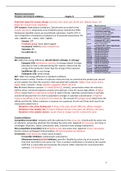Medical biochemistry
Enzymes and enzyme inhibitors chapter 8 04/09/2017
Important organs for energy storage: pancreas, liver, brain, gut, portal vein, adipose tissue, red
blood cell, muscle tissue, lymphatics.
CYP enzymes: Hydroxylases (oxidation). Cytochromes are proteins that
transfer electrons, using heme as its prosthetic group. Cytochrome P450.
Katalyseren dezelfde reactie op verschillende substraten. Familie CYP1-4
voor metabolism of xenobiotics (oxidation) en Eicosanoide biosynthese. RH
+O2 + NADPH +H+ -> ROH + H2O + NADP+.
Enzyme: CYP
Prosthetic group: heme (bind oxygen)
Co-enzyme: NADPH (carrier of electrons)
Substrate: RH
Co-substrate: O2
Thermodynamics
∆G: Gibbs free energy difference. ∆G=∆H-T∆S (H: enthalpy, S: entropy)
Exergonic (<0): spontaneous reaction, no energy needed. Entropy
(disorder) or heat is released during this reaction. Means that the
energy of the products is lower than the energy of the reactants.
Equilibrium: (0): no net change
Endergonic (>0): needs energy
0’
∆G : Gibbs free energy difference in standard conditions
Kcat: turnover number. Number of substrate molecules that are converted into product per second
at one catalytic site when the enzyme is fully saturated with substrate. Higher Vmax means Kcat is
higher. Kcat • enzyme = Vmax. Allosteric regulation affects the Kcat.
Km: Michaelis Menten constant. V= Vmax[S]/Km+[S], Vmax/2, concentration when the velocity is
half the Vmax. Interaction between enzyme and substrate. A low Km means high affinity. A Higher
affinity means that less substrate is needed to reach 0.5Vmax. Substrate concentration is normally
around Km because then it is more susceptible to changes in substrate concentration. A High Km
means a low affinity of the enzyme for the substrate. The amount of hydrogen bonds determines the
affinity and the Km. When mutations in enzymes are suspected, the Km and Vmax both need to be
measured to determine it.
Mutation in the active binding site: If Vmax is the same, but Km different, affinity changed.
Mutation in the catalytic site: If Vmax is different but Km is the same, the affinity is the same.
Mutation in the catalytic domain: causes Vmax to change, but Km is almost the same.
Enzyme inhibitors
Competitive (reversible): competes with the substrate for the active site. It binds with the active site
(or allosteric, preventing substrate from binding the active site). Apparent Km increases, but Vmax is
unchanged. Ibuprofen, statins, bortezomib, zoles, transition-state analogs (oseltamivir).
Non-competitive (reversible): bind at allosteric sites (not active site). Apparent Vmax is decreased,
but Km remains unchanged. Echinocandines. All noncompetitive are allosteric.
Irreversible: Vmax decreases, fewer active enzymes.
Irreversible inhibitors: acetylsalicylic acid (aspirin)
Mechanism-based (suicide) inhibitors: penicillin. Modify the active site of an enzyme. First
they bind reversible to the active site. Then a covalent modification is formed by the enzyme
itself that is irreversible and inactivates the enzyme. MAO, important for neurotransmitter
synthesis. The enzyme kills itself.
1
, Allosteric inhibitors: metabolites bind reversibly at a site other than the active site and changes the
enzyme conformation to make it inactive.
Noncompetitive: binds to allosteric site. Substrate can still bind but enzyme cannot catalyze
the reaction.
Competitive: binds to allosteric site and prevents the substrate from binding.
Brown fat cells produce heat: because they have an uncoupling protein, this protein causes extra H+
to flow in, it releases the proton gradient over the membrane. White fat cells only have a H+ pump,
causing ATP -> ADP -> energy. Brown cells produce heat to keep the body warm when the body is in
hibernation, it is more efficient for heat production than shivering for instance. Brown fat have a lot
of mitochondria. When too much glucose is taken in, it cannot al be saved as free glucose (glycogen).
Therefore, the rest of it is stored as fat by the liver.
Enzymes: Enzymes catalyze reactions by lowering the activation energy, which will enhance the
reaction to start more easily.
Hexokinase: phosphorylates Hexose into Hexopohosphate.
Oxidase: transfers elektrons to oxygen, but oxygen is not part of the product
Oxygenase: transfer oxygen O2 to a substrate. Mono means transfer only one O.
Cytochrome c oxidase: the last enzyme of the respiratory chain. Transfers electrons to
molecular oxygen, which is reduced to water.
Dehydrogenase: transfer of hydrogen atoms and electrons (REDOX).
Reductase: transfer of electrons (REDOX)
Carboxylase: adds a carbon
Decarboxylase: removes a carbon
Kinase: adds Phosphor group
Phosphatase: removes Phosphor group
Classes
Oxido-reductase: molecule is oxidized, while another is being reduced.
Transferase: transfer a functional group, like kinases that transfer phosphate groups.
Hydrolase: catalyse hydrolysis reactions to cleave groups. Proteases, nucleases and
phosphatases.
Lyase (synthase): remove or add groups
Isomerase: reshuffle groups within one molecule
Ligase (synthetase): use ATP to ligate substrates to form one molecule
Redox: reactions where one compound is reduced and one oxidized are performed by oxidases,
oxigenases, dehydrogenases or reductases.
Oxidation: electrons will be extracted from the compound, that is then oxidized. Then those
electrons will be put into another compound, that is then reduced. Energy is won from the reduced
compound. Oxidatie-reductie is verplaatsen van ionen. LOSS. When a compound is oxidized, energy
is released and put into an electron carrier like NAD+->NADH or used for the formation of a proton
gradient. (NAD+). RH ->ROH, substrate RH gains O, so it is oxidized.
Reduction: electrons are gained by the compound. Oxidizing
agent will be reduced to a reducing agent and then gains
electrons. Pyruvate -> lactate GAIN. Reduced form has the
most electrons (NADH)
=O: keton in het midden, Aldehyde aan uiteinde
2




